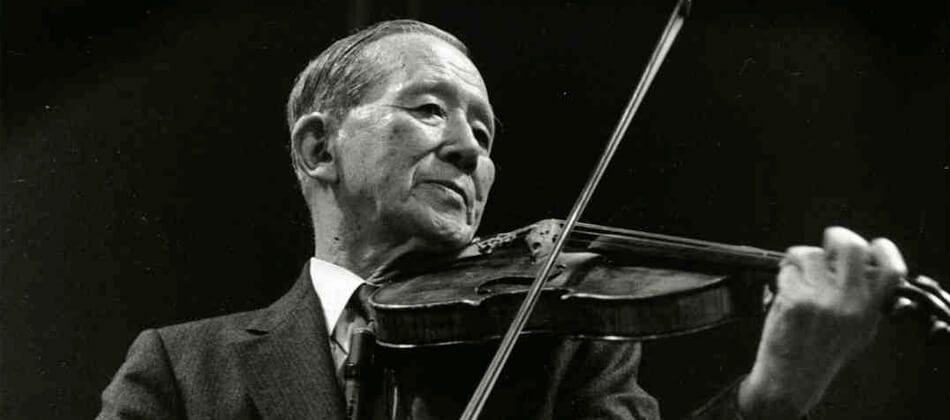
Biography of Doctor Shinichi Suzuki
On January 26, 1998, a milestone occurred in world history, and in education, when Dr. Shinichi Suzuki died in Japan at age 99. This shy, fragile, introspective, spiritual, philosophical and chain-smoking Japanese man founded the Suzuki Method of music education in 1946.This method, which Dr. Suzuki called "Talent Education," became the largest children's educational movement in the world, in history.
Shinichi Suzuki was a middle-aged man in Japan during the Pacific War (World War II), where his parents owned a violin factory in Nagoya. In 1945, after the Japanese surrender, Suzuki, at age 46, wanted to contribute to uplifting the depressed post war spirit in his country by introducing the children to music. He had always marveled how easily Japanese children mastered Japanese, a difficult language to learn, by imitating their parents. He believed that music could be taught in the same way; this was the foundation of his "mother tongue" approach.
Suzuki had studied violin with Karl Klingler in Berlin in the late 1920's, where he met his wife, Waltrude, a singer, who became his life's manager. He was also strongly influenced by the great violinist, Fritz Kreisler, whom he idolized, and the humanist and philosopher, the famous cellist, Pablo Casals. After returning from Europe he started the "Suzuki Quartet" with his three younger brothers and also taught music at a music college in Tokyo starting in 1935. Suzuki, who began to study the violin as an adult, never achieved a high level of professional performance. Nevertheless, he became renowned as a teacher.
In 1946 Suzuki moved to Matsumoto, in the Japanese Alps, an hour's train ride from Nagano City, the site of the 1998 winter Olympic Games. He adapted serious musical pieces from Mozart, Bach and other great masters for his step-by-step method of teaching. His adaptation and variations of Mozart's "Ah, vous dirai-je, Maman" became the familiar "twinkle little star," the theme melody of his method. Suzuki emphasized success by repetition and stressed that a student should not proceed to a new piece until the piece being worked on was thoroughly mastered musically. He stated: "Knowledge is not skill. Knowledge plus ten thousand times is skill." Accordingly, students of roughly the same age achieved different level of repertoire mastery. This concept became difficult for many American parents to accept.
The parent, usually the mother, is an integral part of the method and teaching begins when the child is quite young, often two or three years of age. The violin is remarkably suited to this form of teaching since the instrument can be manufactured to a size sufficiently small to fit the height of the student. The smallest violin for a two or three year old, a 1/64 size, has a body six inches smaller than a full size instrument. Initially the parent is taught to play the violin while the child watches; they also listen to recordings of the music at home. A Suzuki method purist would have the mother listen to the recordings during pregnancy. Early on, the child learns standing position and how to hold the instrument using a simulated violin fashioned from a ruler glued to a cracker-jack box, using a dowel for a violin bow. Of course, the student learns how to bow at the waist correctly in the Japanese tradition.
In Japan, it is not unusual at a Suzuki children's concert to see and hear 500 seven year olds performing Vivaldi and Bach concertos from memory, in unison, and in tune. This remarkable achievement, demonstrated first on films and tapes brought to the US in 1958, and during Dr. Suzuki's children's tour of the United States in 1964, astounded music educators. The method was brought to this country by Professors Clifford Cook of Oberlin College and John Kendall of Muskingum College in the early 1960's after they observed Dr. Suzuki's methods in Japan. The method quickly spread throughout the world and was adapted by Dr. Suzuki and his colleagues for the piano, viola, 'cello, bass, flute, guitar and voice.
The Sixth International Suzuki Method Conference in July 1983 was held for the first time in Japan, in Matsumoto. Several thousand music educators and students from all over the world attended. I had the privilege of attending this conference as a non-musician observer with my wife, Sarah Bishop Minton, who directed the Portland Suzuki Music School from 1973 through 1990. Sarah and I later met and talked with Dr. Suzuki at the Japanese Suzuki Teacher's Conference at Lake Biwa, Japan in 1985, where Dr. Suzuki told us: "Please excuse my English, it was made in Japan." Sarah again studied with Dr. Suzuki daily, at the Talent Education Institute in Matsumoto, for six months between October 1986 and April 1987.
As a cardiologist and non-musician, my background is scientific, factual, and evidence-based, with dollops of the art of medicine added. Nevertheless, I never ceased to be amazed, inspired and, at times emotionally overcome, by the dedication and by the achievements accomplished by the team of teacher, parent and student. "Twinkle," played by a few dozen or several hundred violin students still gives me gooseflesh and brings tears to my eyes. At the Lake Biwa Conference I heard dozens of Japanese tots play lovely musical pieces well, while still in diapers, and unable to grant press interviews because they had not yet learned to speak their native Japanese.
Dr. Suzuki set the standard with his tireless energy, enthusiasm and inspiration and when he returned to Matsumoto from a trip or tour, he always went directly to his school to teach children and music teachers from all over the world, even on Sundays. For almost half a century Dr. Suzuki continued to develop countless innovations and teaching tricks, to enhance the learning process and proper positions of the violin and bow. He recognized the importance of the parent-child relationship in learning and the parent was expected to take notes, supervise practice and keep records of practice times. With very young students a double lesson time was shared so the teacher could shift attention from one student to the other when a student's attention span was exceeded.
Dr. Suzuki's innovations included restructuring the typical music recital. Suzuki students follow a standard sequence of repertoire. In contrast to starting with the most inexperienced student and then proceeding tortuously through the repertoire to the most advanced piece, played by the most advanced student, Dr. Suzuki reversed the pyramid. A Suzuki Method recital begins with the most advanced student, or students, playing the most advanced pieces, such as the Vivaldi Concerto in a minor or the Bach Double Concerto. As the program proceeds through less difficult pieces, all students who have mastered these pieces join the playing group. The advanced students continue to play these easier pieces at their top level of performance ability. The youngest students are kept at rapt attention and anticipation until their opportunity to play arises. Then they play in a large group, playing "real music," along with the most advanced students. This is not only an example of Suzuki's egalitarianism, but a very clever guarantee of an orderly recital, without a lot of very young children running around, seeking an object for their boundless energy and limited attention span.
Dr. Suzuki did not intend to groom musicians to become soloists or orchestral or ensemble performers, although many Suzuki Method students do become professionals. His goal was to develop sensitivity, self worth and appreciation of beauty -soul- in his students so their lives would be enriched. The passing of this remarkable, humble, inspiring man, who dedicated his life to children, "to educate them from the cradle to have a noble mind, a high sense of values and splendid ability," is a significant event in world history. His ageless legacy of millions of Suzuki Method students, teachers and families worldwide will perpetuate his teachings and his name.
Paul R. Minton
February, 1998
